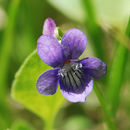en
names in breadcrumbs


Viola adunca (lat. Viola adunca) - bənövşəkimilər fəsiləsinin bənövşə cinsinə aid bitki növü.
Viola adunca (lat. Viola adunca) - bənövşəkimilər fəsiləsinin bənövşə cinsinə aid bitki növü.
Viola adunca is a species of violet known by the common names hookedspur violet, early blue violet, sand violet, and western dog violet. It is native to meadows and forests of western North America, Canada, and the northern contiguous United States.[1][2]
This is a hairy, compact plant growing from a small rhizome system. The leaves are spade- or heart-shaped, sometimes with broadly wavy margins. They are generally 0.5 to 4 centimeters long.[3] The single-flowered inflorescence grows at the end of a very thin peduncle reaching about 7.5 cm (3 in) high.[3] The nodding flower is a violet about 1.5 cm (1⁄2 in) long,[3] with five purple petals. The lower three petals have white bases and purple veining. The two side petals are white-bearded near the throat. The upper two petals may have hooked spurs at their tips.[4][5][6] It is a perennial[7] blooming in late spring.[3]
There are several varieties of V. adunca; a white-petaled form has been noted in Yosemite National Park.
It has also been observed in Southern Ontario in tall grass prairies on the sand plain and in black oak savannas.
Viola adunca is the larval host plant of Myrtle's silverspot. Bees and other insects pollinate it. Polites mardon uses it as a nectar source, and birds and mice use the seed as a food source.[8]
The species is listed as endangered in Massachusetts[2] and in Connecticut.[9]
The leaves and flowers are edible, and can be eaten in salads, as potherbs, or brewed as tea. These plant parts are high in vitamins A and C. However, the rhizomes, fruit, and seeds are poisonous to humans and can cause upset stomach, intestinal problems, respiratory and circulatory depression.[7]
The Blackfoot apply an infusion of the roots and leaves to sore and swollen joints,[10] give an infusion of the leaves and roots to asthmatic children,[11] and use the plant to dye their arrows blue.[12] The Dakelh take a decoction of the entire plant for stomach pain,[13] the Klallam apply a poultice of smashed flowers to the chest or side for pain,[14] the Makah chew the roots and leaves while giving birth,[14] and the Tolowa apply a poultice of chewed leaves to sore eyes.[15]
Viola adunca is a species of violet known by the common names hookedspur violet, early blue violet, sand violet, and western dog violet. It is native to meadows and forests of western North America, Canada, and the northern contiguous United States.
Viola adunca es una especie de violeta. Es nativa de América del Norte, incluyendo el medio oeste de los Estados Unidos desde Nueva Inglaterra hacia el norte a través de Canadá.
Es una planta peluda que crece compacta desde un pequeño rizoma. Las hojas tienen forma de pala o de corazón, a veces con los márgenes ampliamente ondulados. Tienen generalmente de 1 a 4 centímetros de largo. La inflorescencia crece al final de un largo y muy delgado pedúnculo. La flor es de color violeta, con cinco pétalos de color púrpura, los tres inferiores, con base blanca y vetas púrpuras. La parte superior de dos pétalos pueden tener conectados los espolones en las puntas.
Hay varias variedades de V. adunca, con una forma blanca de pétalos que se ha observado en el Parque nacional de Yosemite.
Viola adunca fue descrita por James Edward Smith y publicado en The Cyclopaedia; or, universial dictionary of arts, . . . 37: Viola no. 63, en el año 1817.[1]
Viola adunca es una especie de violeta. Es nativa de América del Norte, incluyendo el medio oeste de los Estados Unidos desde Nueva Inglaterra hacia el norte a través de Canadá.
Viola adunca, ou violette à éperon crochu, est une espèce végétale de la famille des Violaceae.
La violette à éperon crochu est une plante caulescente (à tige) à petites feuilles ovales légèrement pubescentes. La pointe de la feuille est obtuse et la base est subcordée ou tronquée. La plante porte des stipules linéaires.
Les fleurs sont violettes.[1]
Cette violette pousse dans les endroits sablonneux. Elle est présente au Québec.[1]
Viola adunca, ou violette à éperon crochu, est une espèce végétale de la famille des Violaceae.
Є поліморфною багаторічною 1.8–30(35) см заввишки, з невеликою системою кореневищ. Каудекси присутні. Стебла 1–5, підняті, висхідні або лежачі, гладкі або опушені. Листя базальне і стеблове; базального 1–4; прилистки від лінійні до лінійно-ланцетних, поля цілі або поділені, верхівки від гострих до загострених; черешок 0.5–13.5 см, гладкий або опушений; листова пластина зазвичай ± яйцевидні, іноді ± ниркоподібні чи довгасті, 0.5–6.9 × 0.4–5 см, основа серцевидна, субсерцевидна, урізана, поля від округло зубчастих до цілих, вершина від гострої до тупої, поверхні від гладких до рідко або щільно опушених; стеблові листки подібні до базальних за винятком: краї прилистків поділені, черешок 0.5–6.5 см, пластина 0.6–5.5 × 0.4–4.7 см.
Квітоніжка 1.7–13.8 см, гладка чи опушена. Квіти: чашолистки ланцетні, 0.5–2 мм; пелюстки від світло- до глибоко- лавандово-фіолетових на обох поверхнях, рідше білі, нижні 3 зазвичай білі базально, з темно-фіолетовими жилками, найбільш нижні 7–17(23) мм. Капсули коротко-яйцеподібні, 6–11 мм, гладкі. Насіння від темно-коричневого до оливково-чорного кольору, 1.5–2 мм.
Північна Америка: Ґренландія, Канада, США.
Це від сухих до вологих луки, відкритий ґрунт, у тому числі газони, вологі береги, краї луків, скелясті ділянки в хвойних або змішаних лісах, піщаний суглинок, альпійські райони, краї озер; 0–3800 м.
Viola adunca là một loài thực vật có hoa trong họ Hoa tím. Loài này được Sm. miêu tả khoa học đầu tiên năm 1817.[1]
Viola adunca là một loài thực vật có hoa trong họ Hoa tím. Loài này được Sm. miêu tả khoa học đầu tiên năm 1817.